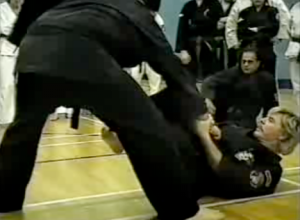Groundwork

When we talk about Kenpo we should understand that the method contains devastating standup techniques. It is often said that Kenpo dose not contain techniques to “deal” with after the defense against a tackle i.e any “Ram” Technique as been executed and failed. If you are a Kenpo novice or perhaps a veteran you may not realize that kenpo contains quite a few redundant techniques that can be applied to the ‘What if’ scenario. Other words a specific Self Defense Technique could be viewed to have ‘Too Much’ and if you hit your attacker with all the strikes it may be considered as over kill — this is where we define this issue as being ‘Over Skilled’. It is this over skilled concept that can be utilized when we tailor American Kenpo Self Defense Techniques to deal with ‘Groundwork’.
Groundwork is the definition of any technique that is used from a prone position normally your back.
The Kenpo method can be described to have five distinct ranges:
1. Out of striking distance of you and your attackers – unable to make contact
2. Within striking distance of you and your attackers – within striking range
3. Contact penetration – The Affective application of striking techniques
4. Contact manipulation – The Affective application of a joint manipulation can be executed.
5. Groundwork – The Application of contact penetration and contact manipulation by employing self defense techniques from a prone position.
Kenpo isn’t a sport!
Before I go on I want to make something VERY clear – Groundwork is the range of which we do not want to hang about in. i.e before someone; and to paraphrase Geoff Thompson is able to do a “56 Kata move on your head” we need to regain our standup as quick as possible. So groundwork should be tailored to meet the need of getting yourself out of trouble by reducing the amount of time on your back in the STREET. Techniques used will enable you to return to a standing position by executing either maiming or even fatal moves so that your attacker is unable to keep up a prolonged assault.
The main offensive and defensive positions are as follows:
The most dominant of all the positions is the mount as you place your entire body weight over and on your attacker.
Mount
This is divided between two positions: High and Low.
The high mount is where your body weight is centered high over your opponent’s chest and your knees are tucked into his armpits.
The low mount is where your body weight is centered low over your opponent’s stomach and your knees are either side of his hips. This is an ideal position to be in for punching and striking.
Half Mount
The half mount is where you have one leg on the outside of your opponent and the other is on the inside of his leg.
Side Mount or Cross Mount
The side mount is achieved by placing your body over your opponent’s chest from either side of his chest. Your knee is tucked into the side of his head and your elbow is controlling the other side of it.
The following are the main Guard or defensive positions used to attain the mount position.
The Guard
The Guard is applied when you are on your back. Your opponent is attacking you from on top and is in the mount position. This is a favored position to be in as they can punch and restrain you from on top. Your legs are wrapped around your opponent torso at the floating ribs.
The Half Guard
The half guard is the same as the guard except that one of your legs is “hooked” on the inside of the groin or thigh area to produce a fulcrum for you to turn your opponent onto his back. Remember to collect his arms to stop him “bridging” out. You then move into the mount position.
The following video was shot at a Seminar in Exeter, Devon UK. Please forward the clip until GM Tatum mentions ‘Groundwork’.
sources: BKKU Seminar footage shot by Matthew Sylvester and Some Wording from http://www.jerseykenpo.com – Other information Wikipedia.
